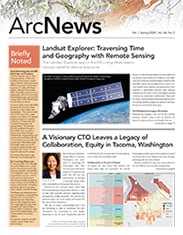Data is everywhere—it’s generated by smartphone activity; credit card transactions; and sensors in cars, homes, and cities. It reveals insights into behavior, preferences, and needs. Smart cities use this information to provide better services to their residents. Brno, a city in the Czech Republic, analyzes open data and uses it to create valuable apps that inform residents and spur data-driven decision-making.
GIS technology and spatial data form the backbone of Brno’s decision-making and policy planning processes. Every day, the system collects and manages data about a wide range of topics, including green space, traffic patterns, and population statistics. In 2018, the city’s Data, Analysis, and Evaluation Department launched a citywide data platform—data.Brno—that uses open data, making information free and available to the public.
Prioritizing Accessibility
Created with ArcGIS Hub, data.Brno is a primary source for city information. It allows anyone to download dynamic data and incorporate it in their projects or systems. The hub site offers about 150 datasets that are regularly updated and accompanied by comprehensive metadata. A valuable internal tool, it’s a shared resource for the city’s primary strategic document, Strategy Brno 2050, and it boosts collaboration across city departments.
Staff members in the Brno Chief Architect’s Office created an extensive zoning plan database using several datasets from data.Brno as well as some of their own. Many conceptual documents, measures, and activities that are needed for the city’s successful growth are created based on data shared on the platform.
The platform’s data is published using open data standards that promote transparency and openness. Residents have immediate access to information regarding local climate, transit, election results, and other aspects of Brno. Data is published in a machine-readable format that is free of license restrictions, easily accessible, and included in a national open data catalog that combines available and open datasets from across the country. The catalog feeds into the official European Union open data portal, contributing to more than 1.5 million datasets from the region.

A Tool That Fosters Innovation
In addition to being compatible with Brno’s citywide GIS, city staff chose ArcGIS Hub because it allows users to easily work with spatial datasets and download data in open formats. Users can directly access data with dynamic, ready-to-use layers; application programming interfaces; or a REST service.
Because of this, anyone can reuse the platform’s open data. A developer who wants to use data about cultural events held in Brno can easily integrate ready-to-use data from the Tourist Information Center into an app or GIS client. Hackathon participants use this data as a foundation for their exercises. High school and university students cite the platform’s data in academic papers, and novice analysts use it to train for their careers. With data from this authoritative source, anyone can create an app or website that includes information about the city.
Storing authoritative data in one place makes it easier for city employees to collaborate and create innovative apps that are integrated into the data portal. The primary aim of these apps is to enable easy access to information to make data-driven decisions. Users can find waste-disposal sites and bike-share locations and get transit information.
Based on information from data.Brno, Brno in Numbers uses a dashboard to visualize basic annual statistics, trends, and interesting facts about the city and its residents in one place. With BRNO BRZO, an app with data.Brno data about recently completed and planned developments, users can access historical information, project plans, and status updates. It’s an essential tool that attracts investors and developers to the city.
Another valuable tool built with the help of the data is a map of solar potential, which visualizes the amount of sunlight falling across the city. This detailed map empowers residents to identify the potential for installing solar panels on their rooftops. By leveraging this information, Brno’s environmental department can strategically plan the installation of solar panels on city-owned buildings, contributing to the city’s efforts to combat climate change.
These apps are valuable for internal and external use. Brno collects real-time data on various transportation modes, including cars, bikes, and public transit. This information enables city staff to anticipate traffic patterns, prevent congestion, and optimize traffic flow. Brno also collaborates with the Waze for Cities program, which provides near real-time international data feeds on road events and traffic speeds. This data informs the planning and maintenance of transportation infrastructure. A public version of the app uses the same data, showing bike and car traffic, available parking, and more.
Planning for the Future
These are just a few examples that show how data is leveraged to enhance Brno’s livability and sustainability. By adhering to high-quality open data standards, the city maximizes the impact of its data and fosters development of innovative tools and applications that benefit residents. The Data, Analysis, and Evaluation Department considers feedback from users, ensuring the portal continues to improve and meet their needs.
Brno relies on worldwide standards and software solutions, so these practices can be replicated in other cities. The hub site provides data-driven approaches to create a healthier and happier city by increasing transparency, optimizing urban management and services, and fueling innovation.
A version of this article was originally published on the data.Brno website.

